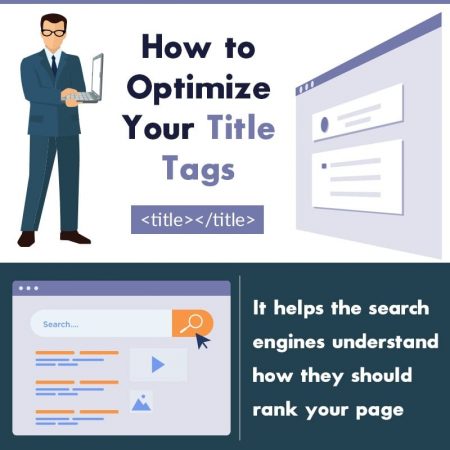 To drive more traffic to your website, optimize your content for search engines, and improve your click-through rates you’ll need to work on page title SEO. This is done by strategically adding optimizing unique meta title tags so that your website becomes more attractive for both the search engines and your readers alike.
To drive more traffic to your website, optimize your content for search engines, and improve your click-through rates you’ll need to work on page title SEO. This is done by strategically adding optimizing unique meta title tags so that your website becomes more attractive for both the search engines and your readers alike.
Title vs. Heading Tags
It’s important to understand the difference between a title and a heading tag. A heading tag appears at the top of your webpage, not on the page of the content itself. They’re identified with a line of “H1” HTML code. It can either be the same as or different from your page’s heading tag. Its job is to provide a preview of your content for your readers.
On the other hand, there are three main places in which a title tag may appear:
- It acts as the headline on your search engine results pages (SERPs).
- When you share a link on social media there’s a snippet that’s populated which shows your page’s title tag, meta description, URL, and featured image.
- Your web browser will show the title tag in the page’s tab so that your users know what tab is when they have more than one tab open.
The Importance of the Title Tag
There are two main reasons why page title SEO and giving each of your website’s pages unique meta titles are so important:
- It helps the search engines understand how they should rank your page. By optimizing your title tag for a targeted keyword you’ll attract search engines and be ranked higher in the SERPs.
- You’ll increase your CTR and attract more visitors to your website.
How to Use Page Title SEO
Now that you see the value in optimizing your page title it’s important to take some time to improve your meta titles. Some of the tasks that are involved here include:
- Make sure your tag length is only 60 characters long.
- Include your keyword near the beginning of the title.
- Give each page a unique title tag.
- Create attention-grabbing headlines.
- Give your reader value and benefits for clicking through to your website.
- Include your brand name after your headline phrase.
Installing a tool like Yoast will help to ensure you do all of these things properly.
Tips for Fully Optimizing Search and Social Snippets
Remember, your title tag is only one of the parts of your meta tag SEO strategy. Every part must work together to improve your page’s appearance when it comes to search engines and social media.
To get the most from your page title SEO you must also optimize both the meta description and the URL itself. This is important because all three of these elements will appear in both the SERPs as well as your social media snippets. You can think of this as an additional opportunity for you to attract visitors and improve your CTR. Here are a few tips to help you with this:
- Search engine optimizes your page’s meta description.
- Make sure that your targetted keyword is used near the beginning of your blurb.
- Keep your blurb 135 – 160 characters in length.
- Create a unique meta description for each page.
- Include a call to action and value proposition.
- Make sure your URL is related to your page title.
- Never use numbers or special characters.
- Keep this blurb short, clean, and concise.
Once you think you’ve created a good page title, it’s a good idea to review it. You don’t want to make any errors or miss out on any optimization opportunities here.
For help with your website’s SEO contact the Local SEO Tampa Company in Tampa, FL today.
